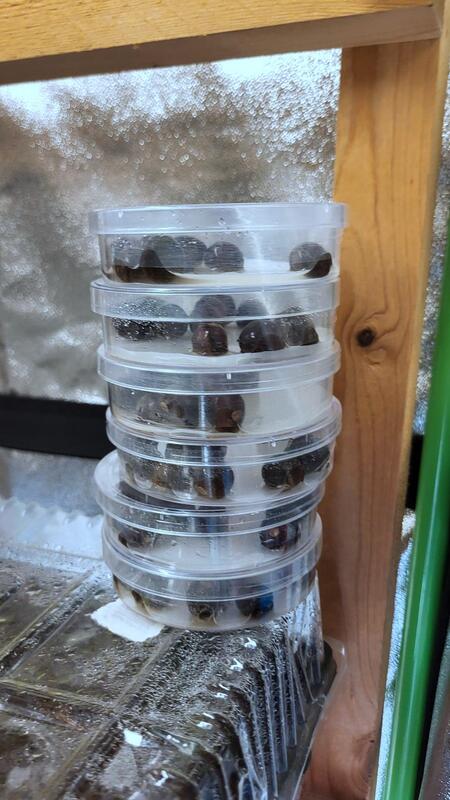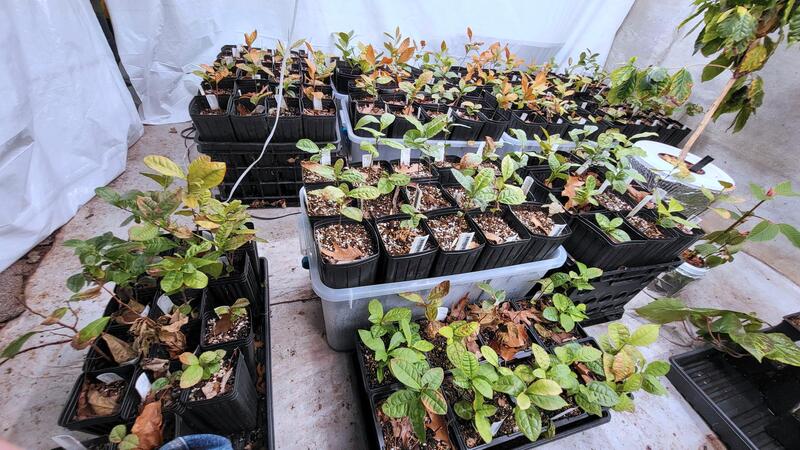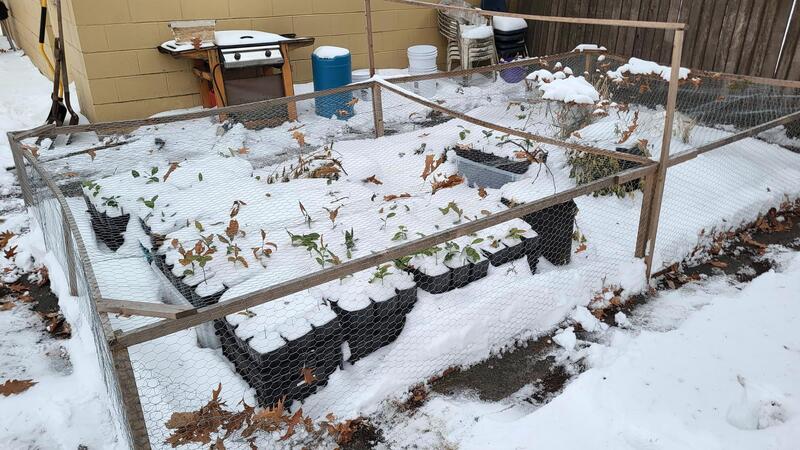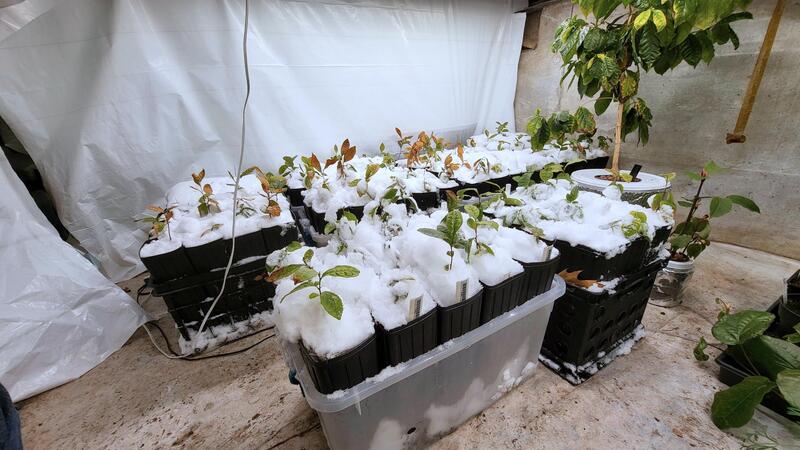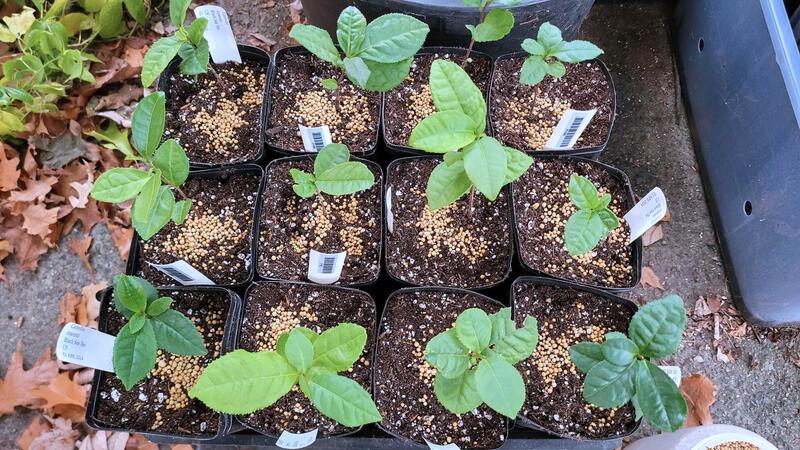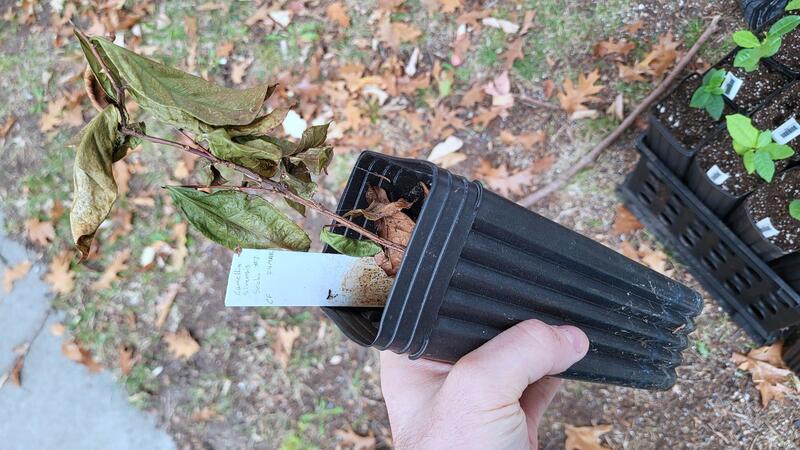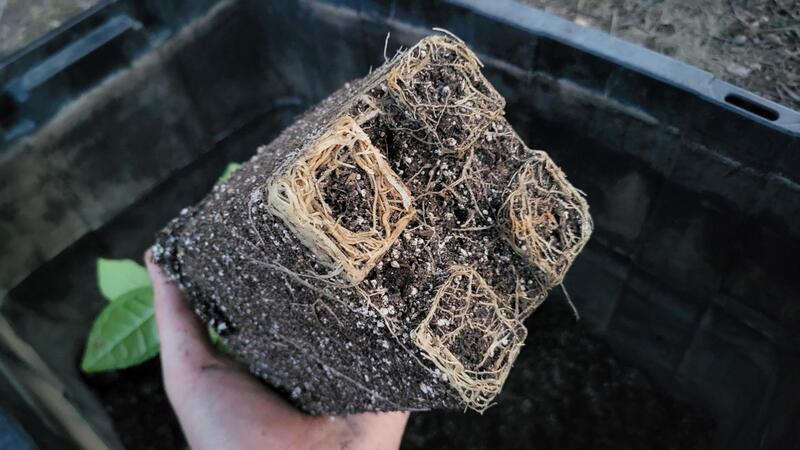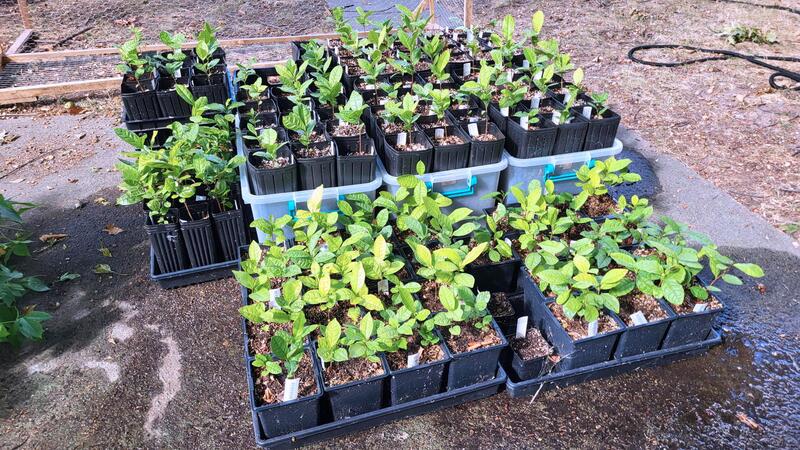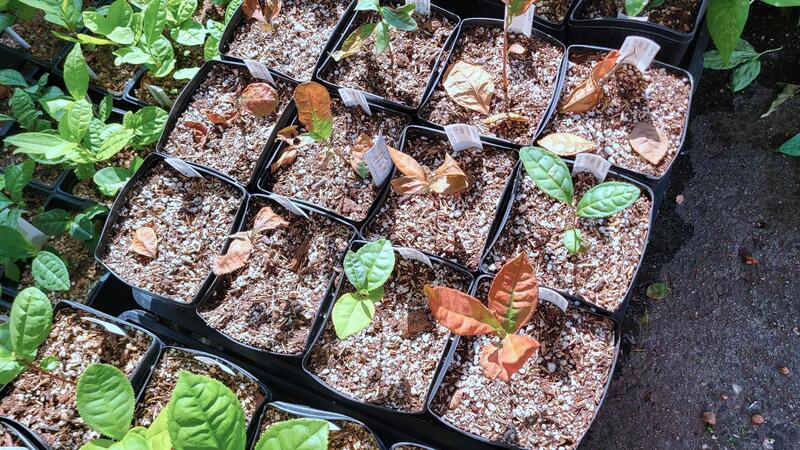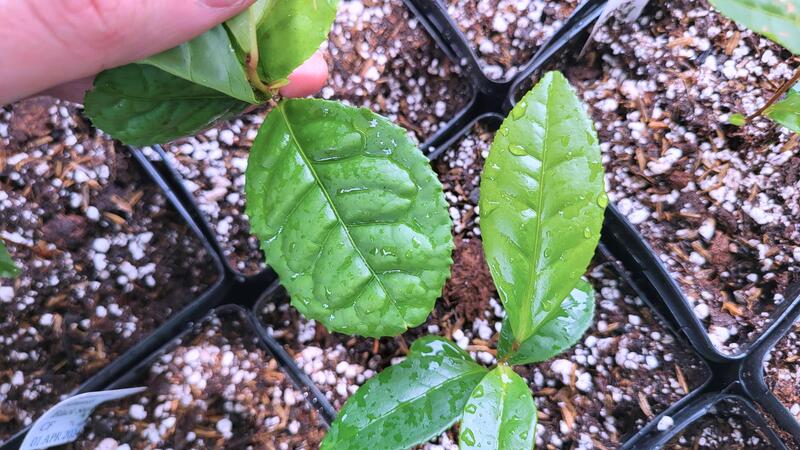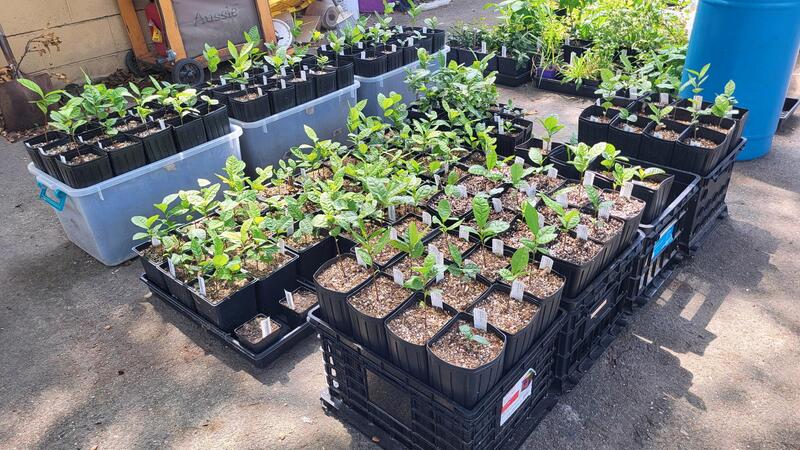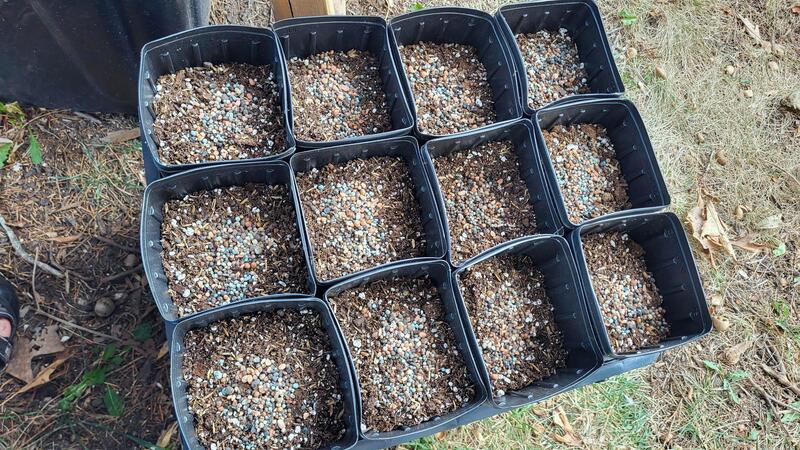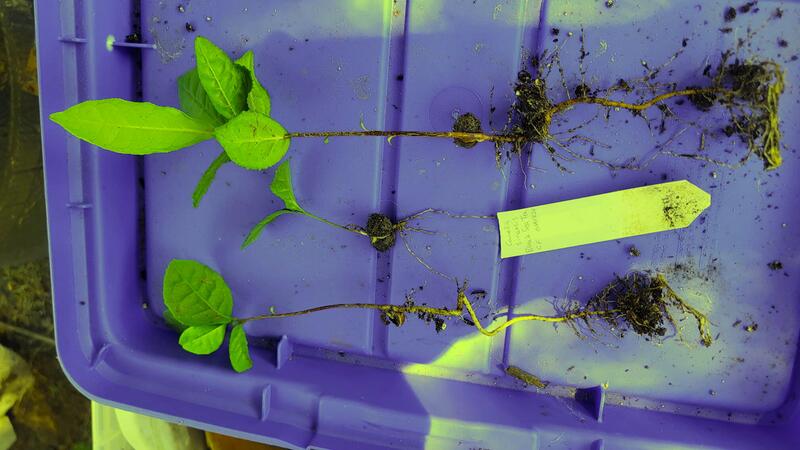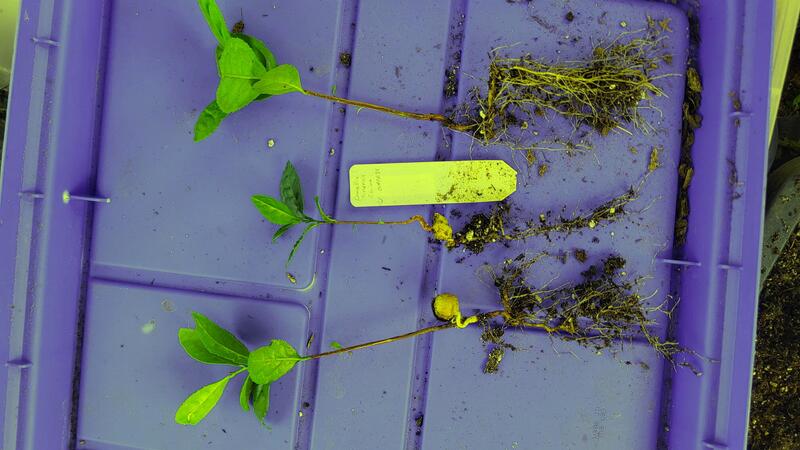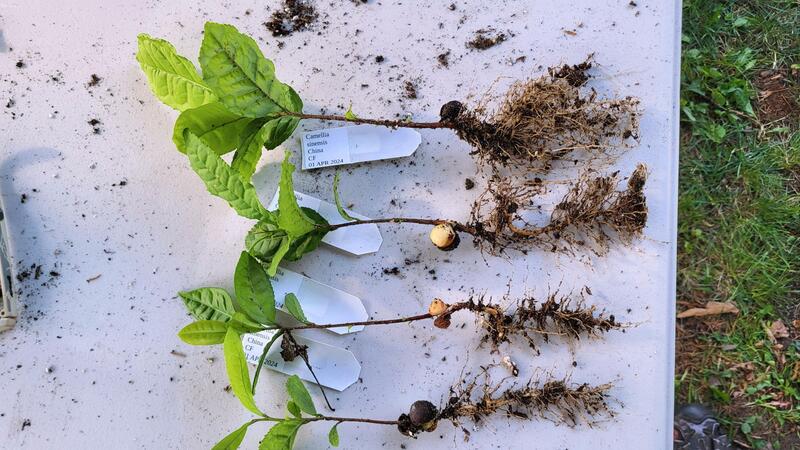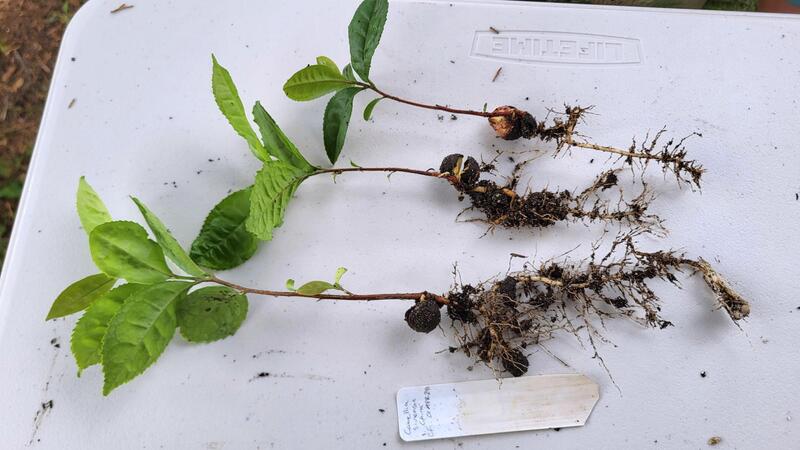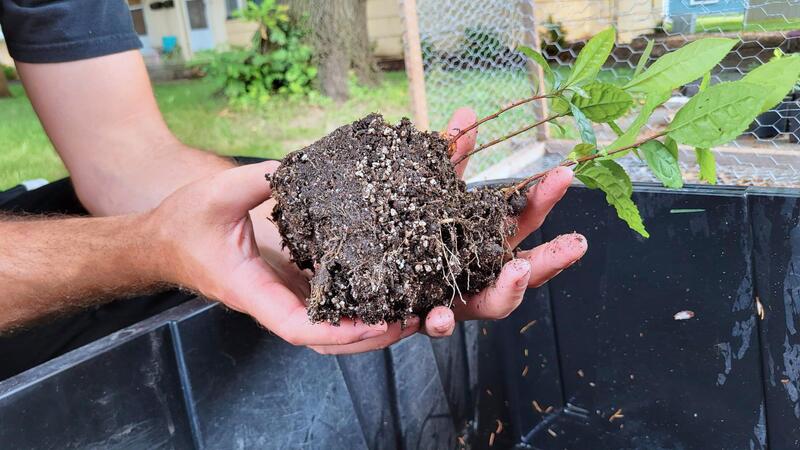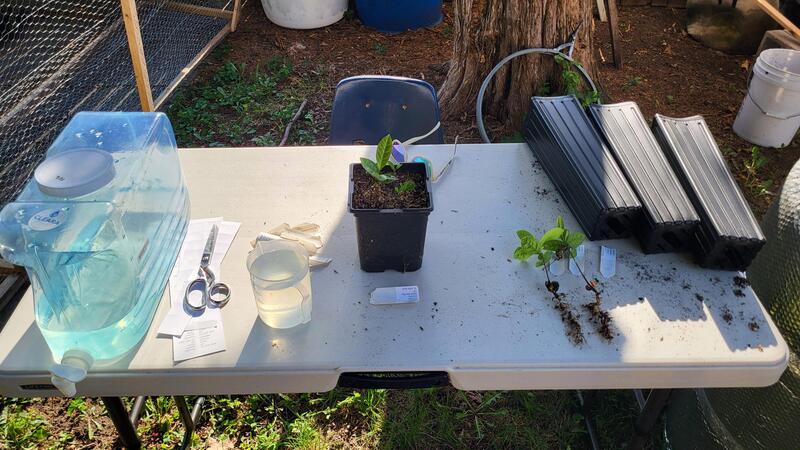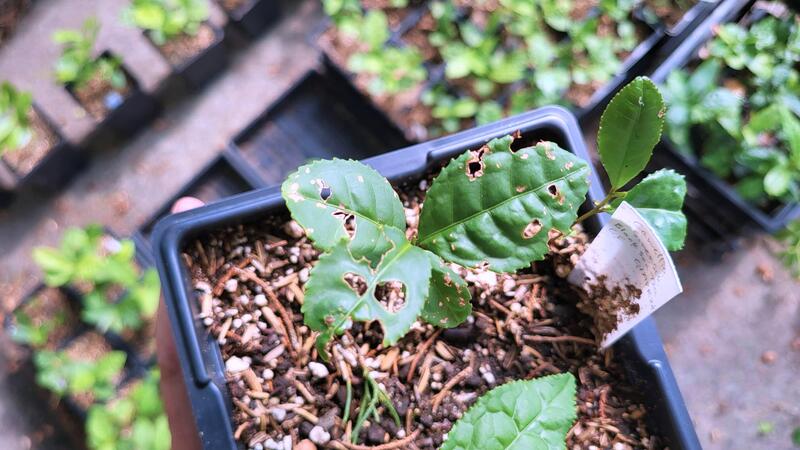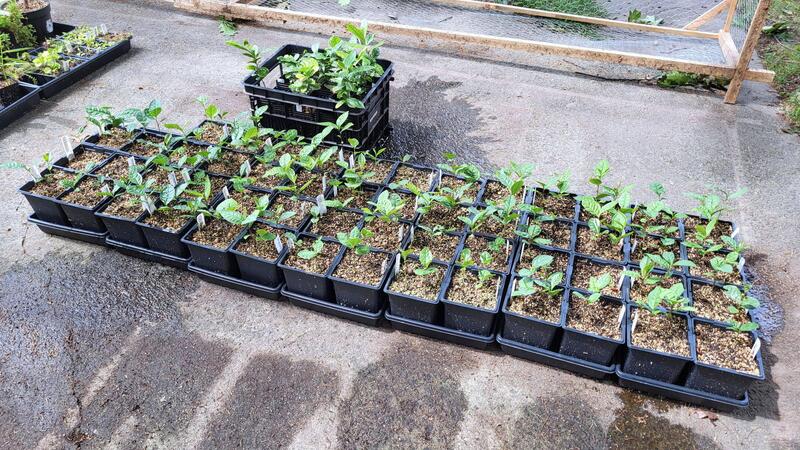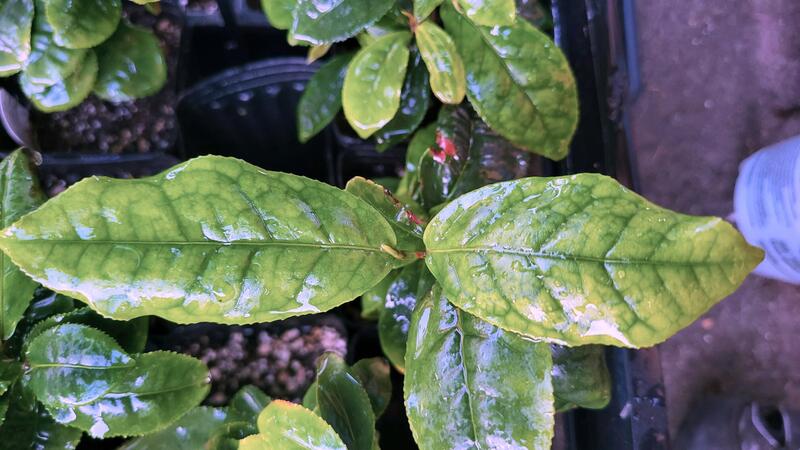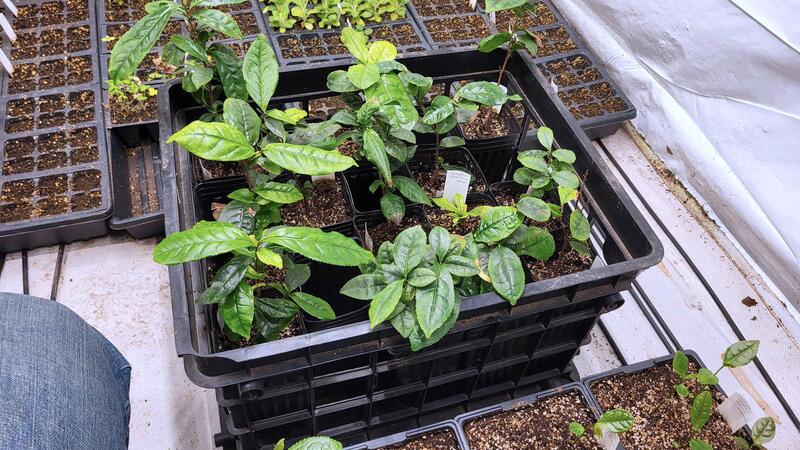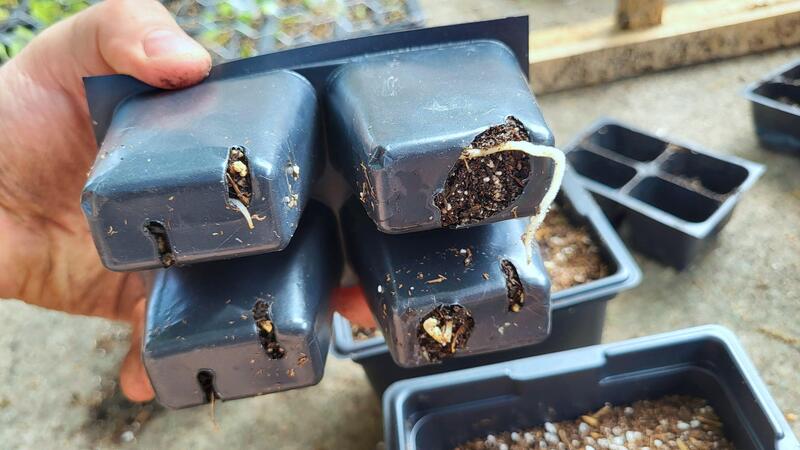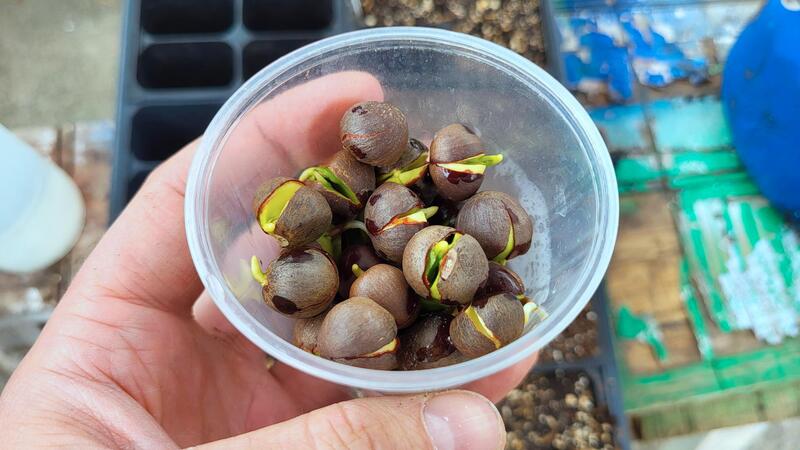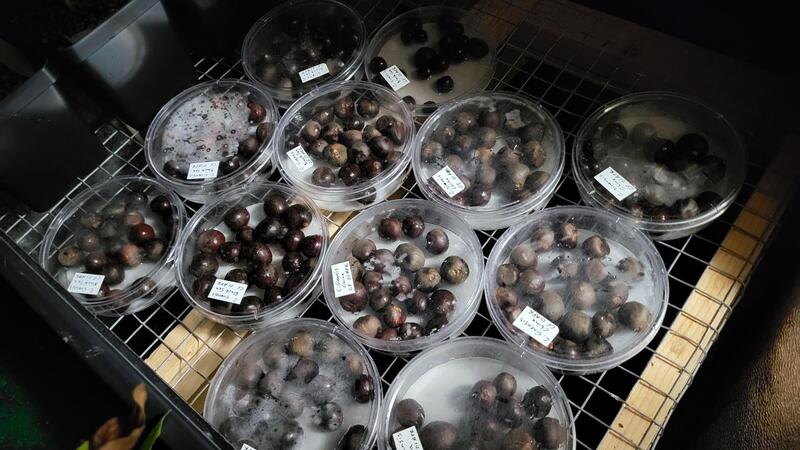Camellia sinensis
Propagation
Germination
Protocol[1]
- [optional] disinfect surface by soaking noncracked seeds in 1% sodium hypochlorite for 15 min
- soak stratified seeds immediately upon receipt for 24 hours
- separate floating from sinking seeds (less likely to germinate and produce healthy plants)
- incubate seeds at 20-25°C in light; keep moist
- move seeds that crack open to vermiculite or other water-retentive media in deep pots
- after 3-4 leaves have developed move to 30-40% shade
- lightly fertilize with slow-release or camellia-specific fertilizer
- gradually move seedling to full-sun at 1 foot tall (1+ years)
| media | germination | temperature °C | note | citation |
|---|---|---|---|---|
| filter paper | 86% | 20/25°C | cracked, fresh seed; 1000ppm GA3 | [2] |
| filter paper | 92% | 20/25°C | cracked; 1-month stratified | [2] |
| filter paper | 89% | 20/25°C | 2-month stratified | [2] |
| filter paper | 94% | 20/25°C | 3-month stratified | [2] |
| 1% agar water | 0-95% | 25°C | desiccation tolerance | [3] |
Cold stratification for 1-3 months in the refrigerator prior to sowing is the typical recommendation for sinensis germination. Discarding or at least separating the floating seeds is also recommended.[1]
Non-deep, intermediate physiological dormancy.[2] Recalcitrant or intermediate storage characteristics.[4][5][6]
Seeds can be surface-sterilized by immersion in 1% sodium hypochlorite solution for 15 minutes.[2][7][5]
Seeds can be stratified at 4°C in Petri dishes.[2]
Fresh seeds will not germinate under normal conditions after two months. Treatment of scarified (“cracked”) fresh seeds with 1000ppm GA3 for 24 hours have a germination rate of 86%. This is very similar to seeds stratified for 2 months (89%) and 3 months (94%) but better than 1 month (64%). Fresh seeds that have not been cracked do not respond to GA3 treatment and will not germinate.[2]
Other research suggests that mature sinensis seeds that are never exposed to low temperatures have a germination rate of at or near 100%. However, no indication of germination time was given except for the termination of the experiment after 3 years of observation.[6]
Seeds planted at a depth of 1cm compared to the surface or 5cm depth have an optimal chance of developing into established seedlings.[2]
The ideal germination temperature depends on the cultivar. Mendhai-dayecha germinates best at 30°C. Yunkang 10 germinates best at 20°C. Fuding-dabaicha prefers 25°C. However, no seed germinates at 10°C.[4]
Mature seeds have a brown pericarp.[4]
Seeds can not be stored at -20°C (freezer) regardless of the moisture content.[3] However, seeds stored in liquid nitrogen for one week or three months have 26.7 or 23.3% germination, respectively. This suggests that some seeds might survive cryopreservation.[7]
Soaking non-desiccated seeds in hydrogen peroxide does not affect germination rates but it can mitigate some of the desiccation-induced damage.[3]
[5] [6] [4] [3] [8] [9] [10] [1] [11] [7] [2] [12] [13]
Vegetative
In-Vitro
| basal media | supplements | source | target | note | reference |
|---|---|---|---|---|---|
Cultivation
| Planting density (m-2) | inter-row space (cm) | intra-row space (cm) | note | reference |
|---|---|---|---|---|
Harvest
Yield
| product | source | yield per season (kg/ha) | note | reference |
|---|---|---|---|---|
| product | source | yield per plant | note | reference |
|---|---|---|---|---|
Soilless
| nutrients | system type | pH | note | reference |
|---|---|---|---|---|
| modified Hoagland | DWC | 4.3 | pH; fertilization | [14] |
| special | DWC | 5.0 | N fertilization | [15] |
Sinensis roots cultivated hydroponically (DWC) can have up to ten times the concentration of theanine compared to field-grown leaves.[16]
Given sinensis’ unusually low pH requirements and preference for ammonium, commonly available hydroponic fertilizers may not be ideal.[17] Masterblend, for example, contains very little ammoniacal nitrogen (~10:1 NO3:NH4).
Soil
| soil type | pH | C-content % | precipitation | temperature (°C) | altitude (m) | note | reference |
|---|---|---|---|---|---|---|---|
Fertilization
| type | rate | time | note | reference |
|---|---|---|---|---|
| superphosphate | targeted: 67-196 kg/ha (P2O5-basis) | variable | application rate | [18] |
| urea | targeted: 310-535 kg/ha (N-basis) | variable | application rate | [18] |
| potassium sulfate | targeted: 76-177 kg/ha (K2O5-basis) | variable | application rate | [18] |
Sinensis prefers low pH (~5.0) and a high ratio of ammonium to nitrate fertilization.[17]
Contrary to earlier research, sinensis can absorb substantial amounts of nitrogen in the form of nitrates. The roots and leaves can then reduce it to form ammonium.[15] However, sinensis fed exclusively with nitrate will develop symptoms of nitrogen deficiency.[17]
The overapplication or misapplication of fertilizer is common in the sinensis tea industry. Incorrect application of one or more nutrients causes a reduction in tea quality and environmental problems.[18][19]
An automated nutrient recommender system “Nutrient Expert” created by IPNI reduced fertilizer usage, increased tea yield, and improved quality compared to expert soil-analysis-based and farmer’s traditional practices.[18]
Nutrient requirements fluctuate throughout the year.[19]
Temperature
Lighting
| fixture type | photoperiod | illumination | note | reference |
|---|---|---|---|---|
Pests
Small green leafhoppers are a serious pest for sinensis plantations.[20]
Ecology
Morphology
| character | measurement | unit | notes | reference |
|---|---|---|---|---|
| seed weight | 1.18 | g | germination | [2] |
| seed weight | 1.92 ± 0.03 | g | germination | [4] |
| seed dry weight | 1.44 ± 0.06 | g | germination | [4] |
| seed moisture content | 47 ± 3 | % | germination | [4] |
| seed MC after stratification | 37 | % | germination | [7] |
Roots
Stem
Leaves
Inflorescence
Seeds
Phytochemistry
| compound | source | concentration (mg/g dry weight) | note | reference |
|---|---|---|---|---|
Infraspecific Variation
[4] zaman_natural_2022 lo_relationship_2023
Biosynthesis
Distribution
Timecourse
Improvement
| trait | improvement status | reference |
|---|---|---|
Identification
| variety | description | reference |
|---|---|---|
Inheritance
Methods
| type | note | reference |
|---|---|---|
Eighteen months is required from anthesis to seed maturation.[6]
History & Society
Work Log
05 May 2025
10 Jan 2025
09 Jan 2025
17 Nov 2024
11 Oct 2024
15 Sep 2024
29 Aug 2024
23 Aug 2024
07 Aug 2024
16 Jul 2024
27 Jun 2024
26 May 2024
15 May 2024
01 May 2024
10 Apr 2024
03 Apr 2024
Sent email to the contacts of the Journal of the Tea Research Association to try and locate a copy of volume 10 of Two and a Bud. The paper “The Classification of the Tea Plant” is cited all the time but it doesn’t seem to be digitized. I doubt that many
https://www.cabidigitallibrary.org/doi/full/10.5555/19640303881
https://www.cabidigitallibrary.org/doi/full/10.5555/19660302202
https://www.cabidigitallibrary.org/doi/full/10.5555/19591604258
02 Apr 2024
Seeds rinsed then placed in groups of 20 in 90mm tall petri dishes on filter paper. 5ml of RO water added. Total 120 seeds of “Black Sea Tea” and 119 seeds of “China” varieties.
01 Apr 2024
MBA needs calcium. Using the concentration of calcium in masterblend nutrients as a basis:
- MB 4-18-38 does not contain calcium
- 0.6 g/l calcium ammonium nitrate
- 19% calcium
- 0.11 g/l calcium
- 2.7 mmol/l calcium
- 0.30 g/l calcium chloride anhydrous
- 0.35 g/l calcium chloride monohydrate
Calcium chloride is hygroscopic. I have no idea what hydrate my CaCl2 is (technical grade ice melt). I’ll dry it in the oven at 400°F, then make a stock solution from the resulting monohydrate.
The calcium can be added to part B of MBA stock if a separate stock is made. I have been using a one-quarter dose of part B of MB, instead, so I need a separate part C. Heh… C for calcium.
| ingredient | part | stock concentration (g/L) | final concentration (g/L) | ratio | dose |
|---|---|---|---|---|---|
| calcium chloride monohydrate | C | 350 | 0.35 | 1000 | 1 ml/L |
Started soaking the new batch of tea seeds. One hundred seeds of each of two varieties. The seeds were soaked in 0.5% sodium hypochlorite for 10 min. The single cracked seed was reserved so it wouldn’t be exposed (labeled “1”). Seeds were then rinsed with tap water 3× times then laid out to dry. They were weighed then immersed in tap water for 24 hours.
28 May 2023
Made a larger stock concentrate MBA2:
| ingredient | part | stock concentration (g/L) | final concentration (g/L) | ratio | dose |
|---|---|---|---|---|---|
| Masterblend 4-18-38 | A | 120 | 0.6 | 200 | 5 ml/L |
| magnesium sulfate heptahydrate | A | 75 | 0.375 | 200 | |
| ammonium sulfate | A | 65.8 | 0.329 | 200 | |
| calcium ammonium nitrate | B | 75 | 0.15 | 500 | 2 ml/L |
This is slightly modified from the previous stock solution to accommodate the poor solubility of part A.
Example for 800 ml stock solution:
Part A
- 96g Masterblend
- 60g magnesium sulfate
- 52.6 g ammonium sulfate
Part B
- 60g calcium ammonium nitrate
Alternatively, 1ml/L of regular calcium ammonium nitrate stock concentrate (150 g/L) can be used.
25 May 2023
Made 7L solution (MBA1-1) of modified hydroponic solution using 28 ml part A and 14 ml part B of MBA1. Adjusted pH to 4 using phosphoric acid, then readjusted to 5 using 7% ammonia (mistake). 1020 ppm.
13 May 2023
Transplanted three of the largest sinensis seedlings (tetraploid #19, 5 9) to 10cm pots using CM1.
CM1
- 1500 ml peat
- 750 ml perlite
- 500 ml masonry sand
- 250 ml worm castings
- pinch of wollastonite
- 18g (1 Tbsp) Expert Azalea fertilizer (10-8-8)
09 May 2023
Half-strength MBA1 was used to fertigate some of the C. sinensis seedlings.
08 May 2023
Ratio of 3:1 ammonium (NH4) to nitrate (NO3) using ammonium sulfate and calcium nitrate.[15]
Making a modified Masterblend formula. Instead of using pure calcium nitrate as the nitrogen additive, I will be exchanging 3x of the nitrogen in the form of ammonium sulfate.
Typical ratios are 0.6 g/L Masterblend 4-18-38, 0.375 g/L magnesium sulfate, and 0.6 g/L calcium nitrate.
Calcium nitrate fertilizer (not pure Ca(NO3)2) is NPK 15.5-0-0. So 0.6 g is 0.093 g elemental N or 6.64 mmol. To get a ratio of 3:1 NH3:NO3 we need 4.98 mmol NH4 1.66 mmol NO3. That’s 0.15 g calcium nitrate fertilizer and 0.329g ammonium sulfate. That’s not exactly correct since calcium nitrate fertilizer contains some ammonium nitrate (~10:1), but it is close enough for testing.
Making a 12.5L test batch (MBA1) (for 50ml and 25ml concentrates):
Part A (4ml/L):
- 7.50 g Masterblend
- 4.69 g magnesium sulfate heptahydrate
- 4.11 g ammonium sulfate
- to 50ml H2O
Part B (2ml/L):
- 1.88 g calcium nitrate fertilizer
- to 25ml H2O
Part A barely dissolved.
23 Mar 2023
Received order of seeds from CF.
- 12 C. sinensis “Small Leaf”
- 12 C. sinensis “Sochi”
- 12 C. sinensis Tetraploid
Bibliography
- D. Sato, “Germinating Tea Seeds (Camellia Sinensis),” Cooperative Extension Service University of Hawaii, Manoa, Hawaii, SCM-17, Mar. 2017.
- D. Song, G. K. Jaganathan, Y. Han, and B. Liu, “Seed Dormancy in Camellia Sinensis L. (Theaceae): Effects of Cold-Stratification and Exogenous Gibberellic Acid Application on Germination,” Botany, vol. 95, no. 2, pp. 147–152, Feb. 2017.
doi: 10.1139/cjb-2016-0149.
There are several different opinions regarding dormancy in tea (Camellia sinensis L.), but there is no strong evidence available to conclude whether or not these seeds are dormant. Freshly matured tea seeds collected from Hangzhou, China, at the natural dispersal time did not germinate in light at daily alternative temperature regimes of 10/15, 15/20, 20/25, or 25/35 °C, or at a constant temperature of 25 °C. Seeds were permeable to water and the embryos did not grow prior to radicle emergence, thus, the seeds have no physical, morphological, or morphophysiological dormancy. When cold-stratified at 4 °C for 1, 2, and 3 months, 64%, 88%, and 93% of the seeds germinated, respectively. Intact fresh seeds failed to germinate after treatment with 0, 10, 500, and 1000 ppm GA3, whereas 3%, 4%, 61%, and 86% of cracked seeds germinated, respectively. Thus, the seeds have nondeep and intermediate physiological dormancy. Seeds cold-stratified for 2 months that were buried at soil depths of 0, 1, and 5 cm in pots showed that seeds at 1 cm depth established significantly higher number of seedlings (P < 0.05) than at other two depths. Because tea seeds are susceptible to summer temperature drying, these seeds do not establish a persistent seed bank.
- H. Chen et al., “Post Desiccation Germination of Mature Seeds of Tea (Camellia Sinensis L.) Can Be Enhanced by pro-Oxidant Treatment, but Partial Desiccation Tolerance Does Not Ensure Survival at −20°C,” Plant Science, vol. 184, pp. 36–44, Mar. 2012.
doi: 10.1016/j.plantsci.2011.12.006.
The maximal potential desiccation tolerance (MPDT) of tea (Camellia sinensis) seeds has been a matter of debate for decades. Here we assessed the ability of tea seeds from three sites in China to germinate after desiccation. Desiccation tolerance was greatest in Kunming, followed by Puer and Lincang, with Kunming seeds tolerating drying to 8% moisture content (MC), or ∼0.5 water activity (aw). Such tolerance was observed in Lincang seeds only when hydrogen peroxide (H2O2) at 0.5 or 1M was applied to seeds, indicating a stimulatory role for H2O2 in post-desiccation germination. Puer seeds exhibited MPDT of 16% MC (∼0.7 aw). Therefore, seeds from all three sites were not recalcitrant. The length of the dry season after dispersal and the high ratio of seed coat to seed mass (>0.3) support the observation of non-recalcitrant behaviour. The seeds were not immature, as the lipid signal in embryonic axes mirrored that of the cotyledons (30% oil). Even after high survival [>60% total germination (TG)] on drying to 10–13% MC, no Kunming seeds tolerated 1 month storage at −20°C coinciding with lipid transitional changes at this temperature. The results indicate that tea seeds from China are neither recalcitrant nor storable at −20°C.
- Z. X. Chen, Q. Y. Lan, L. Zheng, Y. X. Bao, and Y. L. Luo, “Effects of Dehydration and Temperature on Seed Viability and Antioxidative Enzymes Activities on Three Kinds of Cultivars of Camellia Sinensis,” Brazilian Journal of Botany, vol. 38, no. 3, pp. 497–504, Sep. 2015.
doi: 10.1007/s40415-015-0167-5.
The paper studied germination characteristics, dehydration sensitivities, and antioxidative enzyme activities of seeds in three varieties of Camellia sinensis L. [C. sinensis var. sinensis cv. Fuding-dabaicha (Fd), C. sinensis var. assamica cv. Menghai-dayecha (Md), and C. sinensis var. assamica cv. Yunkang 10 (Y10)] during desiccation. The optimum germination temperature was 25 °C for Fd, 30 °C for Md, and 20 °C for Y10. Md, Y10, and Fd seeds were allsensitive to dehydration. GPs of three cultivars decreased dramatically after dehydration for 144 h, reaching values of 48, 37, and 57 % for Md, Y10, and Fd when moisture content declined to 17.5, 17.4, and 14.4 %, respectively. The antioxidative enzymes in Md, Y10, and Fd seeds were not as effective as orthodox seeds, none of them can scavenge ROS timely. Thus, lipid peroxidation accelerated. There were differences between seeds of the three cultivars: Fd seeds were smaller in shape than the other two; Fd seeds showed lower sensitivity to dehydration than the other two; and H2O2 contents in Fd seeds were obviously lower than in Md and Y10 seeds, indicating that antioxidative enzymes in Fd seeds were more effective than the other two.
- P. Berjak, C. W. Vertucci, and N. W. Pammenter, “Effects of Developmental Status and Dehydration Rate on Characteristics of Water and Desiccation-Sensitivity in Recalcitrant Seeds of Camellia Sinensis,” Seed Science Research, vol. 3, no. 3, pp. 155–166, Sep. 1993.
doi: 10.1017/S0960258500001732.
The effect of rate of dehydration was assessed for embryonic axes from mature seeds of Camellia sinensis and the desiccation sensitivity of axes of different developmental stages was estimated using electrolyte leakage. Rapidly (flash) dried excised axes suffered desiccation damage at lower water contents (0.4 g H2O (g DW)−1) than axes dried more slowly in the whole seed (0.9 g H2O (g DW)−1). It is possible that flash drying of isolated axes imposes a stasis on deteriorative reactions that does not occur during slower dehydration. Differential scanning calorimetry (DSC) of the axes indicated that the enthalpy of the melting and the amount of non-freezable water were similar, irrespective of the drying rate.Very immature axes that had completed morphogenesis and histodifferentiation only were more sensitive to desiccation (damage at 0.7 g H2O (g DW)−1) than mature axes or axes that were in the growth and reserve accumulation phase (damage at 0.4 g H2O (g DW)−1). As axes developed from maturity to germination, their threshold desiccation sensitivity increased to a higher level (1.3−1.4 g H2O (g DW)−1). For the very immature axes, enthalpy of the melting of tissue water was much lower, and the level of non-freezable water considerably higher, than for any other developmental stage studied.There were no marked correlations between desiccation sensitivity and thermal properties of water. Desiccation sensitivity appears to be related more to the degree of metabolic activity evidenced by ultrastructural characteristics than to the physical properties of water.
- A. Bhattacharya, P. K. Nagar, and P. S. Ahuja, “Seed Development in Camellia Sinensis (L.) O. Kuntze,” Seed Science Research, vol. 12, no. 1, pp. 39–46, Mar. 2002.
doi: 10.1079/SSR200196.
Seed development of tea was studied to identify the maturity index and the optimal time of seed collection. After harvest, the moisture content (28–30%fresh weight basis) of mature seeds, which germinated 100%, declined progressively (19% moisture content) after shedding, with a decrease in seed germination and viability. However, this viability loss could be prevented to some extent by storing seeds within intact fruits. The maximum rate of seed dry matter accumulation coincided with the accumulation of starch in the embryos and seeds at stage 8, the embryo maturation phase. Although the embryo abscisic acid (ABA) content was highest at stage 8, free ABA declined in the tea embryos throughout the remainder of the seed maturation cycle.
- D. P. Song, G. Jaganathan, Y. Y. Han, G. R. Wu, and B. L. Liu, “Camellia Sinensis Seeds Are Desiccation-Tolerant but Do Not Store Well at Sub-Zero Temperatures,” Seed Science and Technology, vol. 45, pp. 1–6, Dec. 2017.
doi: 10.15258/sst.2017.45.3.06.
Tea seeds are mostly reported to be recalcitrant, i.e. desiccation-sensitive, because drying to 20-30% moisture content on fresh weight basis (MC) results in mortality. Fully-mature seeds, collected at the time of natural dispersal (mid-November) from Hangzhou, China, were cold-stratified at 4°C for two month and dried in airtight containers containing silica gel (1:5 ratio). The MC of the seeds at the time of collection and after two- month cold-stratification was 43 and 37%, respectively. These two-month cold-stratified seeds were dried to 7.9% with 71.7% viability, indicating the seeds were not recalcitrant. Two month cold-stratified seeds dried to 7.9% and stored at -20°C did not germinate after three months. Seed survival at this moisture content was above 70% at various low temperatures when no storage was applied, i.e. if they were warmed immediately, except at liquid nitrogen, where only 56.7% germination was obtained. However, two-month storage resulted in significant viability loss at low temperatures, whereas seeds stored in liquid nitrogen for one week and three months had 26.7 and 23.3% germination, respectively, suggesting that some seeds are able to survive cryopreservation. © 2017 International Seed Testing Association. All Rights Reserved.
- Q. Chen, L. Yang, P. Ahmad, X. Wan, and X. Hu, “Proteomic Profiling and Redox Status Alteration of Recalcitrant Tea (Camellia Sinensis) Seed in Response to Desiccation,” Planta, vol. 233, no. 3, pp. 583–592, Mar. 2011.
doi: 10.1007/s00425-010-1322-7.
Tea seed is believed to be recalcitrant based on its sensitivity to chilling or drying stress. Reactive oxygen species (ROS) and alterations in cytosolic redox status have been implicated in intolerance to desiccation by recalcitrant seed, but there is little information available regarding how ROS are regulated in seeds susceptible to drying stress. We investigated changes in protein expression and activity in tea embryo in response to desiccation using physiological and proteomic methods. Results showed that desiccation treatment dramatically induced the accumulation of H2O2 in tea embryos, accompanied by increased activities of antioxidant enzymes like ascorbate peroxidase (APX) and superoxide dismutase (SOD). Proteomic analyses also demonstrated that 23 proteins associated with defense response, metabolism and redox status were up-regulated following desiccation. Increase in antioxidants, ascorbic acid (AsA) and catalase (CAT) (H2O2 scavengers) partially assuaged desiccation damage to tea seed, resulting in improved germination rates. Higher accumulation of H2O2 aggravated desiccation damage to seeds leading to lower germination activity. We propose that desiccation causes an over-accumulation of ROS that are not efficiently scavenged by increased levels of antioxidant enzymes. High levels of ROS alter the redox status and are detrimental to seed viability. Reducing ROS to appropriate concentrations is an efficient way to reduce desiccation damage and improve germination rates of recalcitrant seeds.
- K. O. George, T. Kinyanjui, J. Wanyoko, O. K. Moseti, and F. Wachira, “Extraction and Analysis of Tea (Camellia Sinensis) Seed Oil from Different Clones in Kenya,” African Journal of Biotechnology, vol. 12, no. 8, 2013.
doi: 10.4314/ajb.v12i8.
Kenyan tea (Camellia sinensis) is widely grown for its leaves and is commercialized as black tea. Product diversification and value addition is currently an area of great interest. This study provides data on the physico-chemical properties of Kenyan tea seed oil from selected clones of tea seeds to ascertain its potential applications. Soxhlet extraction using hexane was employed to obtain tea seed oil followed by chemical analysis to assess its properties. Oil yield, iodine value, saponification value, peroxide value, free fatty acids, total polyphenols and antioxidant activity were determined. The oil yields ranged between 16 to 25% w/w. Iodine value was in the range of 86 to 91 g I2/100 g, peroxide value < 3.5 meq O2/kg, saponification value between 182 to 187 mg KOH/g, free fatty acid < 1.5% oleic acid, total polyphenols 0.036 to 0.043 mg/L gallic acid and antioxidant activity of between 14 to 21% 2,2-diphenyl-1-picrylhydrazyl (DPPH) scavenging activity. Tea seed oil is stable and can be a potential source of natural antioxidants.Keywords: Tea seed oil, iodine value, saponification value, peroxide value, free fatty acids, total polyphenols, antioxidant activityAfrican Journal of Biotechnology Vol. 12(8), pp. 841-846
- P. Patel, B. Das, R. Sarma, and B. Gogoi, “Tea Seed: A Review,” Annual Research & Review in Biology, vol. 25, pp. 1–14, Mar. 2018. doi: 10.9734/ARRB/2018/40418.
- T. H. Seran, M. T. K. Gunasekare, and K. Hirimburegama, “Germination and Subsequent Plant Development of in Vitro Cultured Zygotic Embryos and Embryonic Axes in Comparison to Conventional Seed Propagation of Tea (Camellia Sinensis L.),” 2007.
http://archive.cmb.ac.lk:8080/research/handle/70130/2535.
The present study was carried out to achieve synchronous germination of plant materials into vigorous plants of tea (camellia sinensis 1.), under ex vitro conditions. Sterilized zygotic embryos and zygotic embryonic axes were cultured on MS basal medium supplemented with 3 mg L"1 BAPandO.5 mgL"1 IBA. To serve as controls, seeds were sown in a sand bed. At the 8* week, in vitro plantlets were transferred to ex vitro conditions for acclimatization, and seeds showing different germination responses were separately transplanted. Synchronous and significantly high germination (99%) was observed from cultured embryonic axes in vitro at the 4"’ week of culture, but a lower level of germination (12.7%) from seeds that were sown in the sand bed. Further, healthy plantlets regenerated from embryonic axes in vitro had erect shoots with short internodes, as well as tap roots with abundant adventitious roots under ex vitro conditions, for better adaptation in the field, as compared with seedlings raised by conventional seed propagation.
- T. Suzuki and G. R. Waller, “Allelopathy Due to Purine Alkaloids in Tea Seeds during Germination,” Plant and Soil, vol. 98, no. 1, pp. 131–136, Feb. 1987.
doi: 10.1007/BF02381733.
During imbibition of whole tea seeds (6 days) two purine alkaloids, caffeine and theobromine, did not decrease in the seed coats and there was no increase in the seeds. In parallel with and after the breaking of seed coats there was a gradual release of caffeine from coats of germinating seeds. By contrast, when the seed was freed from the outer seed coat and soaked, imbibition of the seed required only 2 days and simultaneously caffeine was released from the inner seed coat. In such seeds, but not in whole seeds, growth of embryonic tissues (roots and shoots) was inhibited after the breaking of the inner seed coats. Nevertheless, caffeine increased more in such roots of the seedlings of decoated seeds than in roots of normal seedlings.
- Q.-H. Yang et al., “Seed Biology and Germination Ecophysiology of Camellia Nitidissima,” Forest Ecology and Management, vol. 255, no. 1, pp. 113–118, Feb. 2008.
doi: 10.1016/j.foreco.2007.08.028.
Camellia nitidissima Chi (Theaceae) is a famous ornamental species with golden-yellow flowers. Due to deforestation and destructive collection of seedlings, its natural population size has been reduced greatly in recent decades. To provide basic information for its conservation, we studied the morphological and physiological characteristics of seeds and the environmental factors influencing germination. The seed production of C. nitidissima was of low yield, which caused lack of seed resource. The seeds were big and heavy, so they did not spread far from the mother trees and did not enter soil after falling down. Optimal temperatures for seed germination were 25–30°C. The fresh-harvested seeds had high moisture content and weak desiccation-tolerance, so they tended to be recalcitrant. Soaking for 24h in 10–30% PEG solution could significantly reduce the seed germination percentage. The imbibed seeds placed on the soil surface mostly could germinate, but some of them could not develop into seedlings because the embryo roots did not grow into soil. When the seeds were sowed at the depth of 1cm, the seedling emergence reached over 70%, but then decreased with increased sowing depth, and reached about 50% when at the depth of 5cm. The seeds sowed in sandy soil had higher emergence than those in clayed soil. It is feasible for seedling nursing to harvest seeds in time, harvesting prematurely or postmaturely may reduce seed quality.
- S. Kieko and I. Masahiko, “The Function of Roots of Tea Plant (Camellia Sinensis) Cultured by a Novel Form of Hydroponics and Soil Acidification,” American Journal of Plant Sciences, vol. 2012, May 2012.
doi: 10.4236/ajps.2012.35078.
A novel form of hydroponic culture was employed to explore the physiological function of roots of a tea plant (Camellia sinensis). The pH of the nutrient solution with an actively growing tea plant decreased during cultivation. Furthermore, no oxalic acid, tartaric acid, malic acid or citric acid, all possible factors in acidification, was detected in the nutrient solution of a growing plant. A proton pump inhibitor suppressed the acidification of the solution. Soil acidification might have been accelerated with a proton released from ammoniacal nitrogen preferentially for the growth, suggesting the specific mechanism of tea plant as a functional food.
- A. Morita, M. Ohta, and T. Yoneyama, “Uptake, Transport and Assimilation of 15N-Nitrate and 15N-Ammonium in Tea (Camellia Sinensis L.) Plants,” Soil Science and Plant Nutrition, vol. 44, no. 4, pp. 647–654, Dec. 1998.
doi: 10.1080/00380768.1998.10414488.
15N studies were conducted using hydroponically grown tea (Camellia sinensis L.) plants to clarify the characteristics of uptake, transport and assimilation of nitrate and ammonium. From the culture solution containing 50 mg L-1 N03-N and 50 mg L-1 NH.-N, the uptake of NH3-N after 24 h was twice as high as that of NO3-N, while the uptake of N03-N from the culture solution containing 90 mg N03-N and 10 mg NH3-N was twice that of NH4-N. The presence of 0.4 mM Al had no significant effect on the N03-N and NH4-N uptake from the culture solutions containing 50 mg L-1 N03-N and 50 mg L-1 NH4-N, 90 mg L-1 N03-N and 10 mg L-1 NH4-N or 99 mg L-1 N03-N and 1 mg L-1 NH4-N. Transport of N03-derived N to young leaves was much more rapid than that of NH4-derived NO3 and NH4-derived N was largely retained in the roots and lower stem. Young and mature shoots separated from the roots absorbed more N03-N than intact plants. Nitrate assimilation occurred in both, roots and young as well as mature leaves. Internal cycling of N03-derived Nand NH4-derived N from one root part to another part was not appreciable after 28 h, suggesting that a longer of time is required for cycling in woody plants.
- K. Saito, “Roots of Hydroponically Grown Tea (Camellia Sinensis) Plants as a Source of a Unique Amino Acid, Theanine,” American Journal of Experimental Agriculture, vol. 4, no. 2, pp. 125–129, Jan. 2014.
doi: 10.9734/AJEA/2014/5122.
The beneficial effects of green tea are well documented. However, most research has reported the effects of green tea brewed solely from leaves or leaf extracts. We focused on tea roots and developed a hydroponic system to explore the effect on roots that biosynthesize one of the rarest functional amino acids, theanine. The level of theanine in tea roots was much higher than in leaves, which was analyzed using HPLC. Moreover, a higher level of theanine was detected in white rootlets than in lignified roots. Thus, tea roots cultured hydroponically in a controlled environment might be considered a natural drug containing theanine, which could lead to synergistic effects with other ingredients of the root. This novel medicinal material from the roots demonstrates a significant medical function for tea that extends beyond its leaves.
- J. Ruan, J. Gerendás, R. Härdter, and B. Sattelmacher, “Effect of Nitrogen Form and Root-Zone pH on Growth and Nitrogen Uptake of Tea ( Camellia Sinensis ) Plants,” Annals of Botany, vol. 99, no. 2, pp. 301–310, Feb. 2007. doi: 10.1093/aob/mcl258.
- S. Tang et al., “Applying Nutrient Expert System for Rational Fertilisation to Tea (Camellia Sinensis) Reduces Environmental Risks and Increases Economic Benefits,” Journal of Cleaner Production, vol. 305, p. 127197, Jul. 2021.
doi: 10.1016/j.jclepro.2021.127197.
The overuse and unbalanced application of fertilisers have become common practices in the modern world, causing serious environmental problems and restricting tea growth and quality. Therefore, a scientific and rational fertilisation recommendation method should be developed to solve these problems. In this study, fertilisation datasets collected from field experiments (n = 548) in tea-producing areas (n = 21) from 2016 to 2020 were used to build (n = 492) and validate (n = 56) the Nutrient Expert (NE) system for tea. The field validation results indicated that the NE system significantly increased tea yield, quality, economic benefits, and nitrogen (N) use efficiency, as well as decreased greenhouse gas (GHG) emissions. Compared with current farmers’ practice (FP), NE reduced fertiliser-sourced N, phosphorus (P), and potassium (K) application rates by 28%, 25%, and 20%, respectively. On average, NE increased tea yields by 14.0% and 9.3% relative to FP and soil testing (ST). The total concentration of free amino acids, which is one of the most important indexes of green tea quality, were highest in the NE treatment. The net economic benefits of NE increased by 20.0% and 12.6% relative to FP and ST. NE also increased the N utilisation efficiency of tea shoots by 87.0% and 85.3% compared to FP and ST, respectively. Moreover, NE reduced total GHG emissions by 27.7% and 9.6% compared to FP and ST. These results suggest that fertiliser recommendations based on the NE system can increase economic benefits and reduce environmental risks by avoiding excessive fertilisation to maintain sustainable agriculture.
- S. Tang et al., “Temporal Variation in Nutrient Requirements of Tea (Camellia Sinensis) in China Based on QUEFTS Analysis,” Scientific Reports, vol. 10, no. 1, p. 1745, Feb. 2020.
doi: 10.1038/s41598-020-57809-x.
Fertilisation datasets collected from field experiments (n\,= 21) in tea-producing areas from 2016 to 2018 were used to build a quantitative evaluation of the fertility of tropical soils (QUEFTS) model to estimate nutrient uptake of tea plants, and to investigate relationships between tea yield and nutrient accumulation. The production of 1000 kg spring tea (based on one bud with two young expanding leaves) required 12.2 kg nitrogen (N), 1.2 kg phosphorus (P), and 3.9 kg potassium (K), and the corresponding internal efficiencies (IEs) for N, P, and K were 82.0, 833.3, and 256.4 kg kg−1. To produce 1000 kg summer tea, 9.1 kg N, 0.8 kg P, and 3.1 kg K were required, and the corresponding IEs for N, P, and K were 109.9, 1250.0, and 322.6 kg kg−1. For autumn tea, 8.8 kg N, 1.0 kg P, and 3.2 kg K were required to produce 1000 kg tea, and the corresponding IEs for N, P, and K were 113.6, 1000.0, and 312.5 kg kg−1. Field validation experiments performed in 2019 suggested that the QUEFTS model can appropriately estimate nutrient uptake of tea plants at a certain yield and contribute to developing a fertiliser recommendation strategy for tea production.
- J. Li et al., “Habitat Management as a Safe and Effective Approach for Improving Yield and Quality of Tea (Camellia Sinensis) Leaves,” Scientific Reports, vol. 9, no. 1, p. 433, Jan. 2019.
doi: 10.1038/s41598-018-36591-x.
Tea (Camellia sinensis) leaves are used to make the most widely consumed beverage globally after water. Therefore, the safety and quality of raw tea leaves are important indices for making tea and related products. Habitat management has been widely used as an environmentally friendly method to control pests in agroecosystems. To investigate the impact of habitat management on tea plantation ecosystems, a habitat management approach with intercropping was established. The function of habitat management on pest control was evaluated. Furthermore, metabolome and transcriptome analysis were applied to assay changes in quality-related metabolites. The habitat management approach was found to maintain arthropod biodiversity and develop natural arthropod enemies in the tea plantation. Therefore, the yield of the habitat management-treated tea plantation was increased. Metabolome analysis showed that epigallocatechin-3-gallate, the major catechin in tea leaves, has a significantly increased content in leaves of tea plants under habitat management compared with those in the control tea plantation. The content of L-theanine, the major amino acid in tea leaves, was not significantly changed in tea plants under habitat management. Furthermore, aroma compounds were more abundant in tea leaves from the habitat management-treated tea plantation than those from the chemical pesticide-treated tea plantation. Therefore, habitat management is reported for the first time as a safe and effective approach to improving the yield and quality of tea leaves.
